Cleveland class Missile Conversion SBC 140/140A 146/46A
 US Navy 1958-79: Galveston & Providence subclasses:
US Navy 1958-79: Galveston & Providence subclasses:
USS Galveston, Little Rock, Oklahoma City, Providence, Springfield, Topeka (CLG-3-8).
US Cold War Cruisers:
Worcester | Des Moines | Juneau | Boston | Galveston | Providence | Albany class | Long Beach | Leahy | Belknap | Bainbridge | Truxtun | California | Virginia | Ticonderoga | Strike Cruiser (CSGN)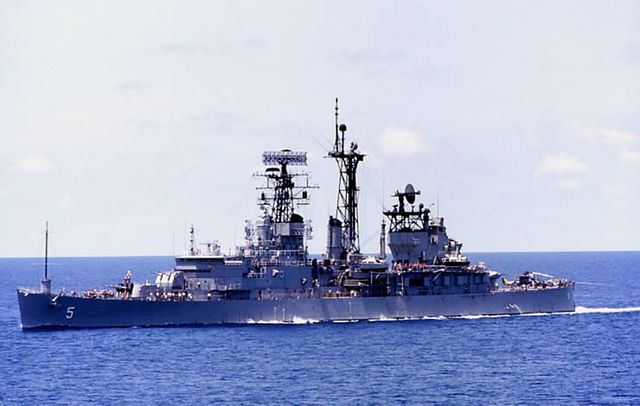
USS Oklahoma City (CGL-5) in 1974
The Boston class were the world’s second missile cruisers, based on the concept pioneered by the conversion of two Baltimore class heavy cruisers, the Boston class. The premises were based on the Soviet threat of high altitude bombers for the US taks forces. The naval staff rather than waiting to have a fully dedicated missile cruiser design preferred to convert existing ships. After the success of the Bostons, recommissioned in 1955-56, reports argued that extra cruisers could follow, but this time on a cheaper and smaller basis to lower the operating costs. At the same time ot was decided to tests a different missile configuration. The Bostons were “full Terrier”, while the new Cleveland would combine Terrier and Talos for more versatility.
In the end, six ships were so converted, sub-class Cleveland and Providence (three each), which differed in details and are separated for some authors. These six cruisers brought a welcome missile protection of the different fleets in activity at the time, especially the 6th (Mediterranean) and 7th Pacific) fleets. They saw action in Vietnam, but less successful, they were discarded in the 1970s.
Undergoing a new Conversion
The Clevelands conversions proceeded from the same idea as the Boston class, providing rapidly a missile capability to the fleet, at a lower cost than building brand new ships altogether. But by the time they entered service, the first generation of dedicated missile cruisers, much smaller and cheaper to operate, the Belknap and Truxtun (1960s). The idea was that Cleveland hulls were far more common that Baltimore class, and like the former, they would retain their forward artillery, making them in effect hybrid cruisers, conventional forward, missile aft. That way they could still retain their shore-shelling asset alongside their missile bubble to protect the fleet.
The Cleveland class cruisers had been a massive undertaking in WW2, for that 52 keels were laid down in 1940, ten converted, 13 cancellations, leaving the remainder 29 to be completed as “light” cruisers. Light only by name as they were decidedly post-1936 in essence, reaching 10,000 tons (11,744 tons standard in the end, for 14,130 tons Fully Loaded), with a 185.9 m long hull, 20.22 m wide and 7.47 m draft, the “light” classification only be retained for their battery of five triple 6-in/47 rapid fire guns. The recipe was tested already by the preceding Brooklyn class. Thus, after the war, most were still in active service, not planned for retirement before the late 1950s. This was a bounty on which to tap for conversions.
There was a catch however: The Cleveland were designed from 1938 on prewar treaty limitations not to go further 10,000 tonnes and it showed in their moderately wide hull to keep the displacement down. This was to cause headaches afterwards when extra AA armament were installed. They ended overweight and dangerously unstable, unlike the Baltimore class, a wartime design that already jumped to 15,000 tonnes and above. There was no guarantee that the weight of the radars, new structures and their derrick masts would be balanced accurately. In the end, it was not despite engineers efforts. And this played against them, and a short career, ended in the early 1970s, so barely ten years. Among numerous critics, they were found too cramped, and notably upgrades were impossible, as well as any use as command ships. There was no surprise when the naval staff retook Baltimore class hulls for the next conversions of the 1960s, the Albany class, “pure” missile conversions (no artillery left).
Design of the CLG Reconversion
Historically, the conversion was performed in two batches which were sufficiently different for most authors to separate: The Galveston (CLG-3 to 5, Galveston, Little Rock, Oklahoma City) and the Providence class (CLG-6 to 8, Providence, Pringfield, Topeka). By simplicity they will be treated in this article in one go as strongly related, untlike the previous Boston and following Albany. They were indeed all hybrid cruisers based on Cleveland class hulls. CLG stands for Guided (missile) Light Cruisers (CLG) to differenciate them from the previous CG-1/2 (Boston class) or Albany (CG-10, 11, 12). First off the choice of converting three hulls at first was dictacted by permanence at sea in one of the two main fleets: One ship in short maintenance/crew’s rest, one in overhaul, and one at sea. Since they were operaying on a roughly peacetime operation 6-months deployments, one was supposed to replace the other so to cover an entire year of presence a sea. With two classes, the two main fleets (6th Med, 7th Pac) were guaranteed to have always at least one missile fleet escort.
The Galveston (CLG-3) class (SCB 140/140A)
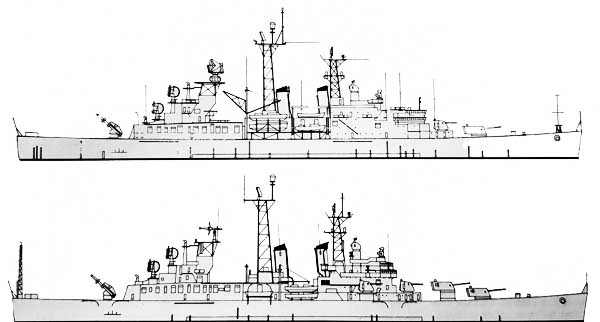
Conway’s profiles of USS Little Rock (SBC 140A) and USS Galveston below (SBC 140)
The Galveston class was fitted with the RIM-8 Talos long-range surface-to-air missile system. There was for this a two-year refit called project SCB 140, consisting of:
-Aft superstructure down to the deck and below guttered and replaced
-All aft guns, removed twin-arm Talos launcher
-A 46-missile storage magazine.
-Three large masts installed for main and secondary radars, FCS, communications antennae.
Command ships:
USS Little Rock and Oklahoma City in addition differed from USS Galveston as being simultaneously converted into fleet flagships (SCB 140A program): And for this, they had their two forward dual 5-in/38 turrets either side, and one triple 6-in/50 removed: The forward 5-in/38 was pushed well forward, in place of N°2 main turret. This elabled space to install a brand new expanded bridge, longer, wider, and roomier. Galveston kept her original Cleveland-class forward standard, with the same bridge, but new derrick mast, same three dual 5-in/38 and her two forward superfiring triple 6-in turrets.
Plagued like their near-sister ships of stability issues, aggravated by all the topweight, they had a short career. This was very much like the Providence class but their stability problems were even worse, and not caused by the radars and masts but rather their cumbersome missile system. As the heavier Talos took much more space and bulk than the Terrier equipped Providence. Weight reduction measures consisting in adding ballast but this affected their seakeeping and performances overall. Galveston in additiono suffered alone from hogging of the hull. So much so that bracing was envisioned during her first overhaul, but this was not carried out. Instead she was the first to go.
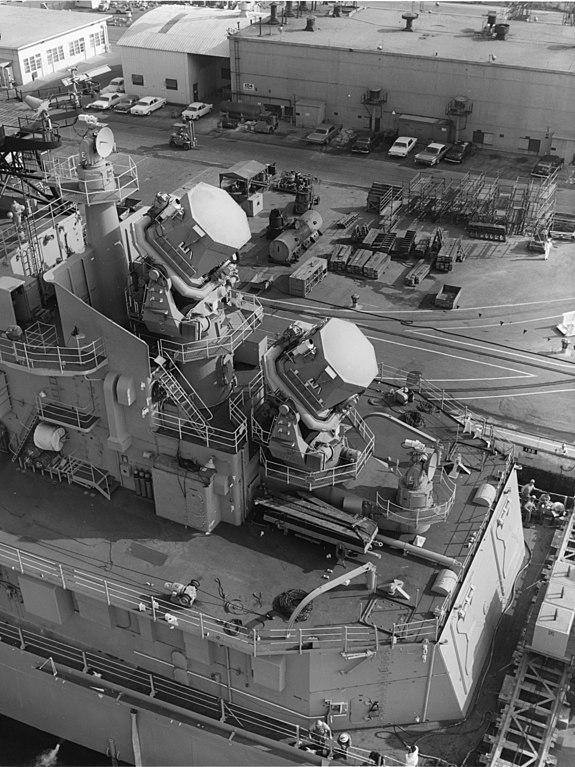
Talos and Guidance system on USS Oklahoma City in 1963. Note the two huge missile loading doors, giving an idea of the scale of the missiles.
The three Galveston-class were decommissioned, placed in reserve between 1970 and 1979 and before beign stricken, they were reclassified in 1975 “CG”. Stricken 1973, 1979. But they had very different fates: USS Galveston was scrapped, Oklahoma City was sunk as a target (1999) after a long reserve, and Little Rock had been, saved, restored and converted to be open to the public as museum ship, now an attraction in Buffalo, New York.
Providence (CLG-3) class (SBC 146/146A)
Nothing revolutionary, this class was a follow-up and again, Providence, Springfield, and Topeka differed between them, as Providence and Springfield were the only ones outfitted as fleet flagships. But their major difference was to operate the Terrier surface-to-air missile system instead of the Talos, which was a gift for stability as seen above. They came out with the same series of modifications over two year of refit as project SCB 146/146A (command ships)
-Aft superstructure replaced by 4-stepped one for FCS and mast
-All aft guns removed for twin-arm Terrier launcher
-120 missile storage and belt conveyor magazine behind and below.
-Three large masts installed for radars, FCS and coms.
Providence and Springfield were the SCB 146A following exactly the same redesign as 140A (Little Rock and Oklahoma City). Topeka followed the same design as USS Galveston.
The Providence’s stability problems were a bit lessened by their lighter missile system, but still, during their first overhaul, ballasting was added to improve stability. They also suffered from hogging of the hull. After a short career they were decommissioned between 1969 and 1974, reclassified CG the next year, stricken in 1974 to 1980, all three sold for scrap.
Armour protection revisions CLG-3
Like the Boston class (CAG), the CLG cruisers received a protection upgrade. It consisted of:
-Main belt abreast the machinery now 4.2m high, 5-in thick but 3.26 in at lower edge backed by 0.6 in STS plating.
-Narrow belts abreast the magazines.
-Fore belt 2-in (51mm) thick
-Aft inner belt 5-in thick.
-Magazines now protected by 3.66-in (93mm) bulkheads fore and aft
-Machinery and magazines separated by 5-in down to 2-in bulkheads.
-Armoured deck, over the main belt 2-in (51mm).
-Barbettes still 6-in (152mm) thick
-Turrets degraded to 165 mm faces, 32 mm sides, 32 mm rears, 51 mm crowns. instead of 152/76/32/76mm
Armament:
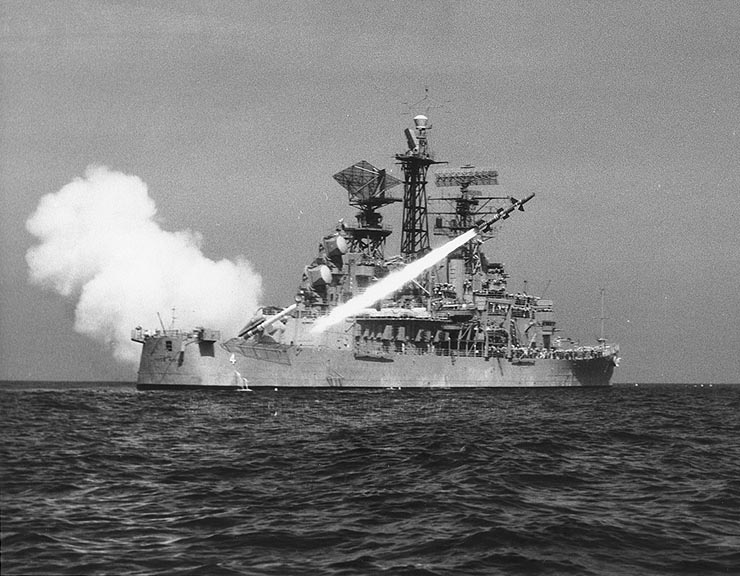
USS Little Rock fie testing her RIM-8 Talos on 4 May 1961
Main Guns: 1/2x 6-in/47 Mk.16
One or two forward only triple 6-in (152 mm) gun turrets.
Each barrels weight 6.5 short tons (13,000 lb; 5,897 kg). Fires the 130 lb (59 kg) armor-piercing Mark 35 (super heavy) or the 105 lb (48 kg) HC (high capacity) Mark 34/39. It could elevate to 60°, at 8–10 rounds per minute, at 2,665 ft/s (812 m/s) for the HC Mark 34. As said above: Project 140/146 kept their two formard turret. Project 140A/146A only had their “A” turret left. It clearly made them less interesting for fire support.
Secondary Guns: 1/3×2 5-in/38 Mk 32
Again, this differed between the 140/146 (Three) and 140A/146A (Just one forward). Standard 5-in/38 (127 mm) dual purpose, standard of the USN in WW2 and arguably one of the world’s most successful dual purpose (surface/AA) gun in history. Used from destroyers from 1936 to 1945, cruisers to aircraft carriers (fleet and escort) and battleships. Full detail here.
RIM-8 Talos Missile System (Galveston)
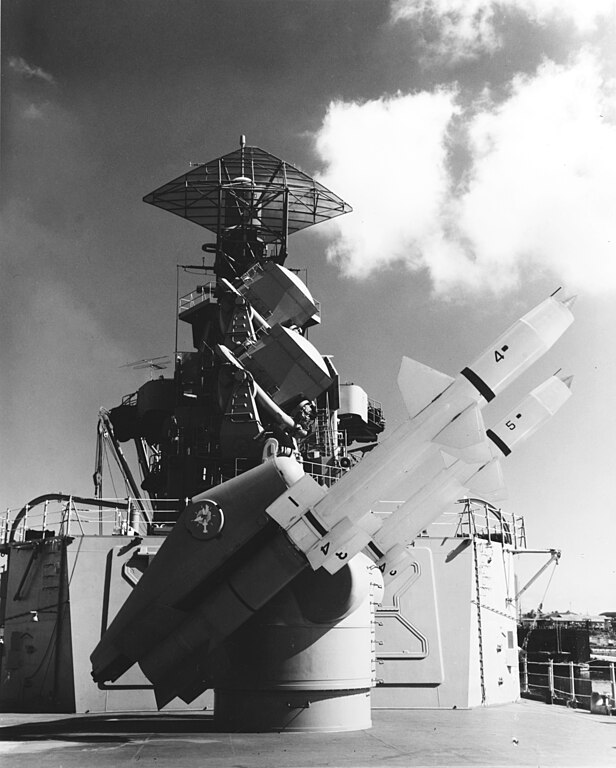
RIM-8 Talos on USS Little Rock
CLG3 and 4 had a twin Talos SAM launcher (46 RIM-8 in storage), CLG4 and 5 (command ships) also had a twin Talos SAM launcher (46) but an helicopter deck.
Inaugurated on USS Galveston in 1958. Homing semi-active, 2.5 Mach, 100 nautical miles, 80,000 feetf ceiling, continuous-rod warhead. Costly, bulky, heavy, but the most capable 1st-generation SAM, only compatible with (large) cruiser hulls. In Vietnam war, Talos claimed three MiGs.
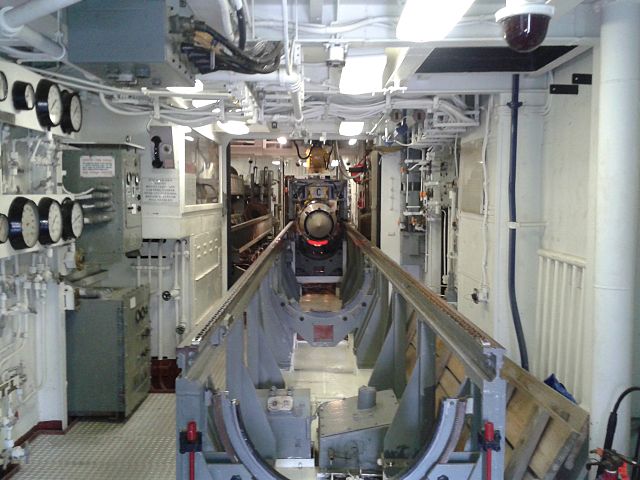
RIM-8 Talos missile loading conveyor aboard the USS Little Rock. Missile bodies would enter the room from storage on this conveyor to be fitted with a warhead and transferred to the magazine racks.
Mark 4 RIM-2 Terrier Missile System (Providence)
The RIM-2 Terrier concept was initially close to the Talos, but diverged, becoming smaller, medium-range. Blast-fragmentation system warhead. Wing-controlled, beam-riding Mach 1.8 over 10 nautical miles. Tail-controlled, semi-active radar homing, up to mach 3 over 40 nautical miles and up to a 80,000 feet ceiling. Standard with a single aft twin launcher with quick reload, complex conveyor belt system.
CLG-6 had an aft twin Terrier SAM launcher (120 in storage), as well as two twin 6-in/47n three twin 5-in/38 Mk 32, same but on CLG7 and 8 but reduced artillery and one helicopter deck.
Sensors
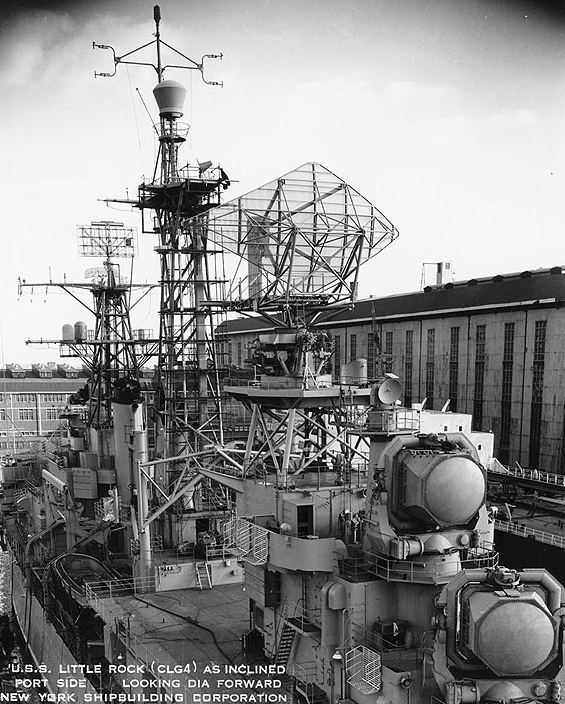
Radar suite on USS Little Rock while in Completion at Camden, NJ.
CLG3 and 5 (Galveston and Oklahoma City) had the SPS-8B, SPS-29, SPS-39, two fire control SPG-49/SPW-2, Mk 13 and Mk 25 radars, plus the WLR-1 and ULQ-6 ECM suites.
On CLG4 Little Rock, these were the SPS-17, SPS-2, instead of the SPS-8B and 29.
For the CLG6 to 8, all three ships, these were the same SPS-8B, but SPS-10, same SPS-29/39, but two SPQ-5 for the Terrier missiles, and same Mk 13 and 25 assoviated radars, ECM suite.
AN/SPS-8B: Air warning 2D radar 500 kW, L Band, range 130 – 260 km (70 – 140 nmi)
AN/SPS-17: 1957 GE/ITE made, 1.5 MW working on P-Band, 215-225 MHz, 10 𝜇s, Range 200 nmi (370 km)
AN/SPS-2: 1957, 10 kw 3D L Band 240 Hz 6 µs with a 620 km (330 nmi) range.
AN/SPS-29: Eight finding 2D 650 kW radar, S Band at 1000 Hz (bwt 3.5°, pdt 2 µs) Range 111 km (60 nmi)
Mark 25 radar:
AN/SPS-39: Huges 1MW Surface-search 3D radar (1960), S Band 1850 Hz 4 µs range 296 km (160 nmi)
SPG-49/SPW-2: Guidance radar RIM-2 Terrier, used on the Providence class after the Boston.
WLR-1: Radar warning receiver (RWR) 1960s. Direction-finding, processing, evaluation 0.5-18 GHz (C-J) bands.
ULQ-6 ECM suite: Deception repeater used in combination with the AN/WLR-1 receiver.
Note: All six were not modernized.
Air Group
Only for the command ships: 140A and 146A: Helipad aft, no hangar and either a UH-2B or SH-3G helicopter. They came in handy in Vietnam.
⚙ Galveston specifications |
|
| Displacement | 11,066 tons standard, 15,152 tonnes FL |
| Dimensions | Same but 7.80 m draught instead of 7.47 m |
| Propulsion | Unchanged |
| Speed | 32 knots instead of 32.5 kts original |
| Range | 8000 nm at 15 kts, oil 2,661t |
| Armament (Galveston) | 2×3 6-in/47, 3×2 5-in/38, 1×2 Talos SAM |
| Sensors (1955) | SPS-8B, SPS-29, SPS-39, 2x SPG-49, Mk 13 & 25, WLR-1, ULQ-6 ECM |
| Protection | Modified, see notes |
| Crew | 1,382 officers and enlisted |
General assessment
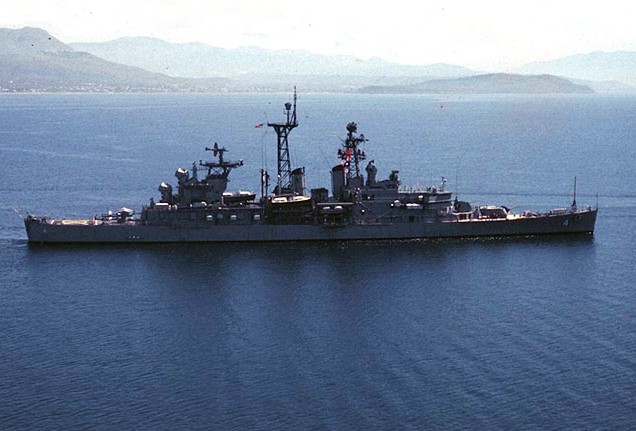
USS Little Rock in the Med, 1974
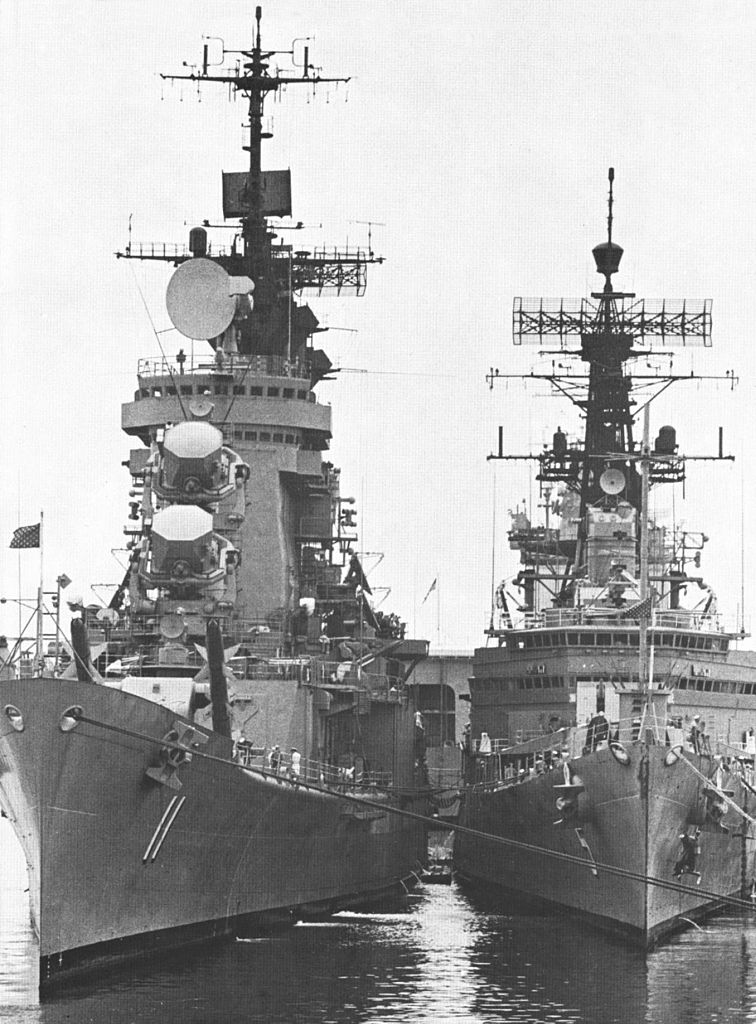
USS Oklahoma City and Chicago in 1967, North Island. It shows the stark difference in her bridges. Just let’s recall here that Oklahoma and her sisters were supposed to have excessive top-weight already…
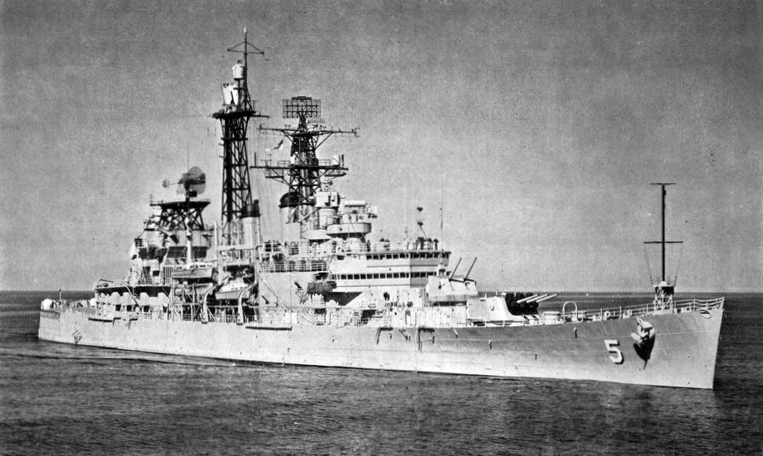
USS Oklahoma City in 1961
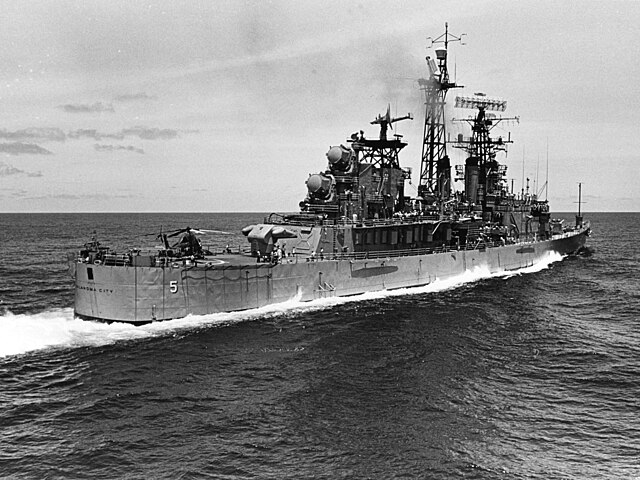
USS Oklahoma City’s stern view underway, showing her large size relative to her helicopter, South China Sea 13 July 1966.
More
Books
Links
wiki Galveston-class_cruiser
wiki Providence-class_cruiser
usslittlerock.org galveston_class
on navypedia.org
militaryfactory.com cl93-clg3
 USS Galveston CLG-3 (rec. 1958)
USS Galveston CLG-3 (rec. 1958)
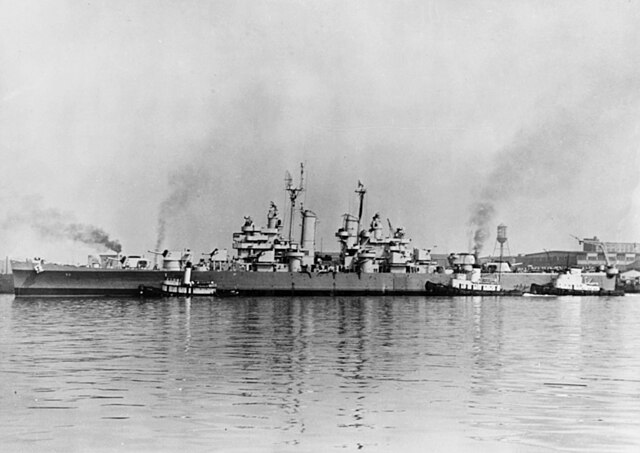
USS Galveston, never completed by wartime, was placed in reserve for a later reconversion, here out of Philly NyD, 24 May 1946.
Galveston was chosen because of her late completion: She was indeed launched at William Cramp & Sons in Philadelphia on 22 April 1945, completion suspended on 24 June 1946, and placed on the Atlantic Reserve Fleet. Reclassified CLG-93 on 4 February 1956 AND CLG-3 on 23 May 1957 she was rebuilt as the first CLG, commissioned at Philadelphia on 28 May 1958.
On 30 June 1958 she performed builder’s trials off Norfolk, Virginia Capes, quite successful, including firing her Talos missile.
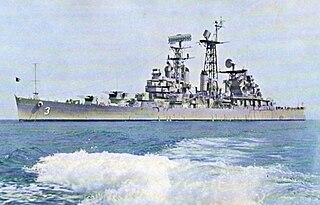 It was a world’s first for a SAM to reach such a range at Mach 4. Next she was sent to San Juan (Puerto Rico) by 16 January 1959 for training-evaluation in the Carribean, for another at sea Talos fire on 24 February 1959. Admiral Arleigh Burke stated: “the best antiaircraft missile in any arsenal in the world”. She was back for fixes in Norfolk on 17 March and Philadelphia.
It was a world’s first for a SAM to reach such a range at Mach 4. Next she was sent to San Juan (Puerto Rico) by 16 January 1959 for training-evaluation in the Carribean, for another at sea Talos fire on 24 February 1959. Admiral Arleigh Burke stated: “the best antiaircraft missile in any arsenal in the world”. She was back for fixes in Norfolk on 17 March and Philadelphia.
In July 1959, she at last made her shakedown/acceptance trials, refresher training cruise off Cuba and testing in exercizes the rest of her electronics and com. with realistic scenarios with the USAF. On 4 January 1960, she sailed to Charleston and operated to Puerto Rico and the Virgin Islands. She visited Galveston on 16 February for a dedicated Silver Service presentation. She later unloaded ammunition for shock tests off the Bahamas (for the whole class) and entered Philadelphia NyD on 25 March 1960. When done, she departed Virginia Capes on 24 October 1960. On 6 January 1961 she went to the Bureau of Naval Weapons technical evaluation to further evaluate her Talos system off Jacksonville and off the Virgin Islands, until 1 March. It’s only later off San Juan that she made her final acceptance trial off Guantanamo Bay…
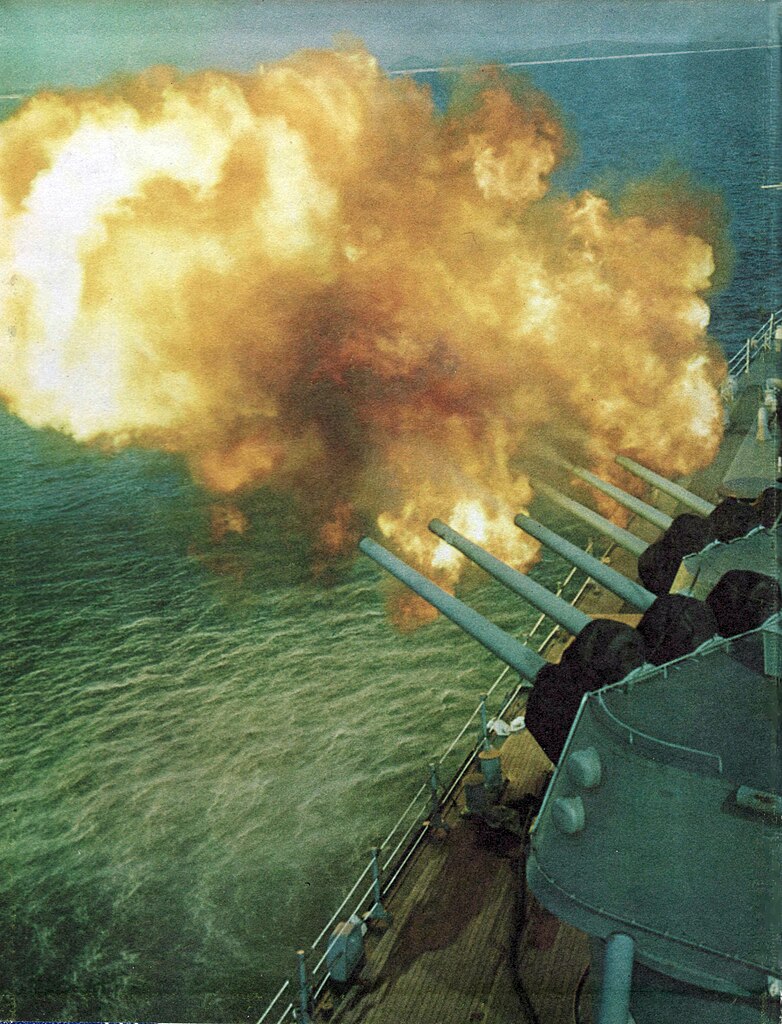
On the gunline, blazing, 1965: Bombarding the shore off Vung Tuong area.
Back to Norfolk on 9 April, she sailed to Jacksonville (8 May) with the Operational Technical Evaluation Force and more extensive testing. She made a Talos fire in front of 17,000 visitors at Cape Canaveral during the May Armed Forces weekend. Later she was poverhauled at Philadelphia NyD from 30 August 1961 to 23 July 1962, with additions and modifications to her fire control system, rounded at Charleston (electronic fixes). At last she departed on 23 July 1962 for San Diego and join CruDivFlot 9, on 24 August, home-ported in San Diego, firing this time her Talos at an old destroyer escort, demonstrating her anti-ship capabilities. She left the West Coast by October 1963 for the Western Pacific as flagship and the 7th Fleet off Japan, also visiting Taiwan and back to San Diego on 16 April 1964. She had another OVL between October 1964 and February 1965 and by June she was sent to the South Vietnam, via Subic Bay on 21 June and the 7th Fleet for 5 months in Southeast Asian waters, notably in the Gulf of Tonkin, providing gunfire support at Chu Lai, Vung Tuong. She was back at San Diego on 18 December.
Back in January 1966, via Hawaii she made tests and returned for another modernization from 31 July to 4 November and by 1967 transited to the East Coast, Atlantic Fleet duty and Mediterranean, 6th fleet.
On 19 October 1968, she made her last Westpac, split between Yankee Station and Da Nang, relieved by USS New Jersey (BB-62). She spent on the gunline 3,500 rounds over 9 days notably for the Korea Marines in the Delta. Back home on 2 February 1969 she left for the East Coast, Atlantic-Mediterranean fleets, but by 1970 she was placed in the Pacific Reserve Fleet in San Diego. In 1975 she was sold for scrap and BU.
 USS Little Rock CLG-4 (rec. 1960)
USS Little Rock CLG-4 (rec. 1960)
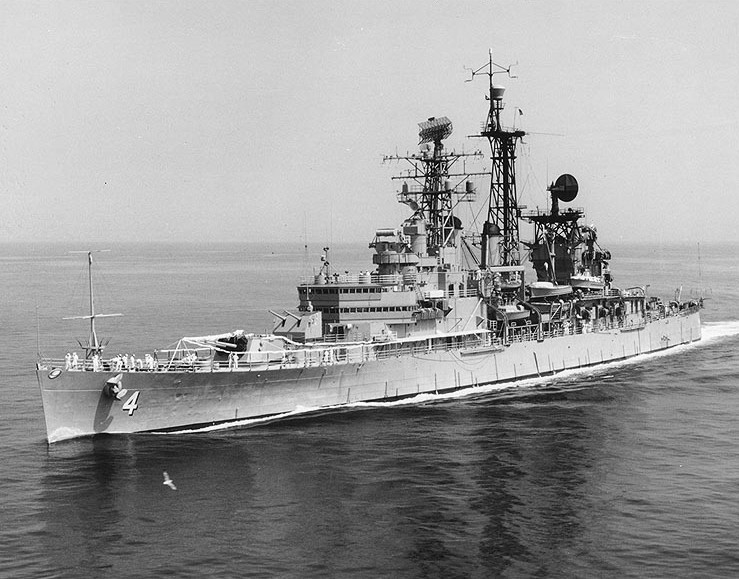
USS Little Rock was built at William Cramp, launched 27 August 1944, commissioned 17 June 1945, so she saw the dying days of WW2 while in shakedown and training between Cuba and the Atlantic coast. She was homeported to Norfolk and by October sailed for a 5-month South American cruiser, back to Norfolk on 23 March 1946 followed by east coast exercizes.She made her first overseas deployment from 4 June with the 6th Fleet, for all the summer and back on 27 September followed by the escort from November of USS Missouri to Davis Strait (Task Group 20.2) for a large scale cold-weather exercises from Greenland to Baffin Island. When firing a 5-inch star shell a misfire and the round cooked-off while the gun was pointed downwards by safety, and hit Missouri on the signal bridge, killing Coxswain Robert Fountain. Until 1949 the cruiser stayed on the east coast with two deployments to the Mediterranean in 1947 and 1948. Decommissioned 24 June 1949 she was placed in reserve and years later selected for converison ending this process on 23 May 1957. Recommissioned at Philadelphia 3 June 1960, (J. O. Phillips), she had her shakedown training and fired her Talos missiles.
Leaving Philadelphia on 9 February 1961 she spent 6 months with the 6th Fleet and back to HP Norfolk by September. On 18 November 1961 she was ordered off Santo Domingo after the assassination of Rafael Trujillo. Next she made four yearly Med TODs with the 6th fleet. She was even flagship in May-December 1963. In 1966 she had an overhaul and the nexy year relieved her sister USS Springfield as 6th Fleet flagship, based in Rota, Spain and HP Gaeta in Italy. She witnessed the Six-Day War as NATO command ship. By mid-1970, she collided with the Greek destroyer Lonchi and was repaired at Malta. She had her majot carrer overhaul in Boston by late 1970-spring 71. By 5 June 1975 she was present at the reopening of the Suez Canal, transited from Port Said to Ismaïlia and Alexandria.
The spring of 1976 saw Talos SAM deactivated and plans to modernize her with a new SAM were dropped after a survey showing the poor conditions of her machinery. Sent in Norfolk she was decommissioned late 1976. But arrangements with the Navy secured her preservation as Museum ship, towed via the Saint Lawrence to Buffalo, New York (Buffalo Naval & Military Park) and witnessed he commission of the new USS Little Rock (LCS-9), a first.
 USS Oklahoma City CLG-5 (rec. 1960)
USS Oklahoma City CLG-5 (rec. 1960)
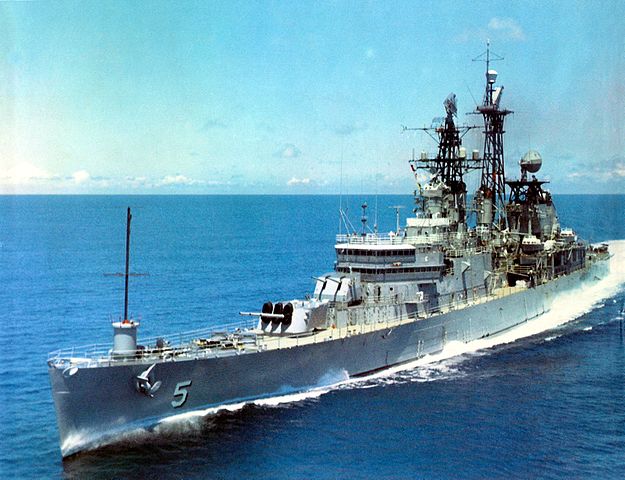
Oklahoma City being commissioned in 1944, saw substantial action in the Pacific, being a rugged veteran on V Day. She was decommissioned, reserve, in June 1947, and nearly ten years later was selected for conversion. On 7 March 1957 she entered Bethlehem Steel Corp. near San Francisco for conversion until 31 August 1960. After shakedown training she became the first USN ships ti fire a Talos in the Pacific Fleet. She trained as flagship, CruDiv 3 and CruDesFlot 9, making a 6-month WestPac deployment, operating from Yokosuka. She trained with the 7th Fleet and SEATO, granted two “E” awards and paying good will visits before back to Long Beach, training and upkeep, restricted availability and overhaul.
By early 1964 after a refresher training she arrived at Yokosuka on 7 July as 7th Fleet flagship and quickly led the way after the Tonkin Gulf incident, for a first 25-day alert. From June 1965, she started her first gunfire support mission and later operations “Piranha”, “Double Eagle”, “Deckhouse IV”, and “Hastings II.” In late 1966 to mid-1967 she had an OVL in San Francisco and was back by the winter 1968-69 on the gunline. By April 1969 she trained in the Sea of Japan with three carrier groups after the North Korean downed an EC-121 spy plane. By July she fell under the Commander Cruiser-Destroyer Force ans CruDivFlot 6, HQ San Diego, flagship 7th Fleet and of TG 70.1 and under TG 70.8.9 on the gunline, HP Yokohama.
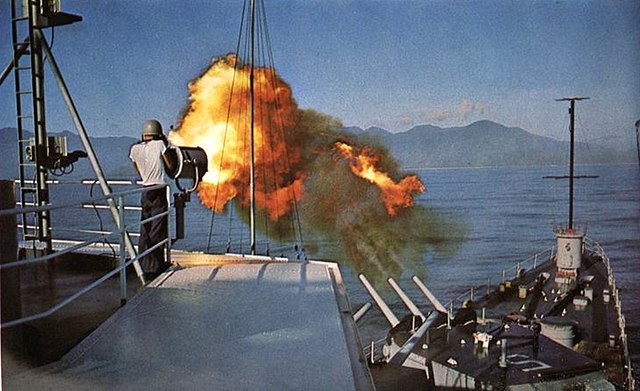
Gunfire support 1965-66
Back to Yankee Station in September 1969 she used her helicopter for several operations, made her first RAS with USS Ashtabula, visited by RADM Isaman, and RADM McClendon. While later underway she had an incident in boiler 4, leaking, fixed. At Okinawa she took part in Exercise Z-3l-GM (short range Talos fire), and on 4 February 1972 fired a live RIM-8H anti-radiation missile on a North Vietnamese mobile air control radar van, a world’s first. On 19 April 1972 MiG-17s from VPAF 923rd Fighter Regiment armed with bombs attacked her. Two bombs were dropped near, causing light damage but the destroyer USS Higbee received a direct hit but survived. In April 1975 USS Oklahoma City took part in Operation Frequent Wind (evacuation of Saigon). Back home she was in for a massive overhaul. The plan including removal of the Talos, two Sea Sparrow systems, two Phalanx CIWS installed, machinery renewed. Funding was appropriated by Congress but diverted elseswhere and only cosmetic changes were made until decommission on 15 December 1979
Based in the reserve, Suisun Bay until 9 January 1999 she was towed to Pearl Harbor, stripped, and ended as target in February–March for air-launched missiles in Tandem Thrust ’99 off Guam, finished off by the South Korean submarine Lee Chun, 27 March 1999. She was, between vietnam and WW2 Pacific service the most decorated of all Galverston class cruisers, with 13 battle stars.
 USS Providence CLG-6 (rec. 1959)
USS Providence CLG-6 (rec. 1959)
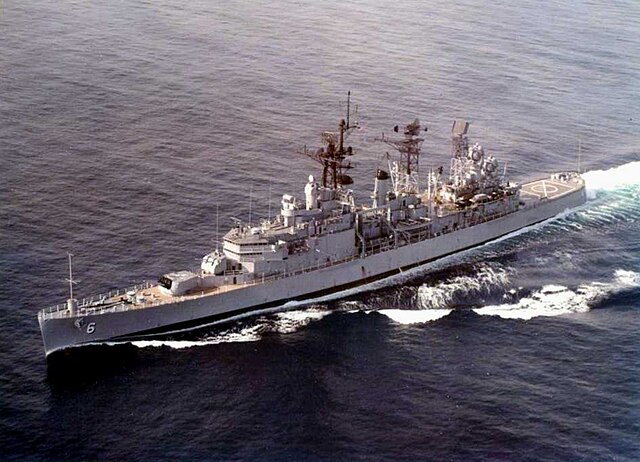
After a short WW2 (she was completed on 15 May 1945) service, she had some extra years in her conventional form, Mediterranean TODs 1946-49. She was decommissioned at Boston on 14 June 1949, Atlantic Reserve Fleet. selected for conversion she was reclassified CLG–6 on 23 May 1957, at Boston in June 1957. She was the lead ship of the RIM-2 Terrier missile variant, called the Providence class. She had command ship facilities, nuclear weapons capability and was fully recommissioned on 17 September 1959. After shakedown in Guantanamo Bay, HP Long Beach by July 1960 saw her making a 6 month WestPac TOD, 7th Fleet and back in March 1961. By May 1962 she relieved USS Oklahoma City as flagship. 1962-1963 exercises ended in Saigon and took part in Project Handclasp. She left Japan for home in July 1964, back in October in the Eastern Pacific. In January-June 1965 she received her new communication suite, and stayed on the West Coast, 1st Fleet.
She made another WestPac on 12 November 1966, replacing Oklahoma City as flagship 7th Fleet in December 1966 at Yokosuka and took her place on the gunline in Vietnam on 1 April 1967. She destroyed a shore battery off the DMZ on 25 May and later convered amphibious operations notably at Da Nang in October. 1968 was the same with pauses in June and December. In February 1968 she took part in the Tết Offensive, shelling The Citadel in Huế. She took part in Operation Formation Star, and accompanied three carrier groups in the Sea of Japan after the NK captured of USS Pueblo, receiving her first Navy Unit Commendation for her actions until November 1968. 1969 saw her with the 1st Fleet, West Coast.
She left San Diego for another TOD in Vietnam, April-December 1972 and a second Navy Unit Commendation in 1973. She was decommissioned on 31 August 1973, stricken on 30 September 1978, sold on 15 July 1980. She earned the Vietnam Service Medal with 6 campaign stars (one silver and one bronze), Vietnam Navy Gallantry Cross with Palm device and Vietnam Campaign Medal, probably the most decorated of the class.
 USS Springfield CLG-7 (rec. 1960)
USS Springfield CLG-7 (rec. 1960)
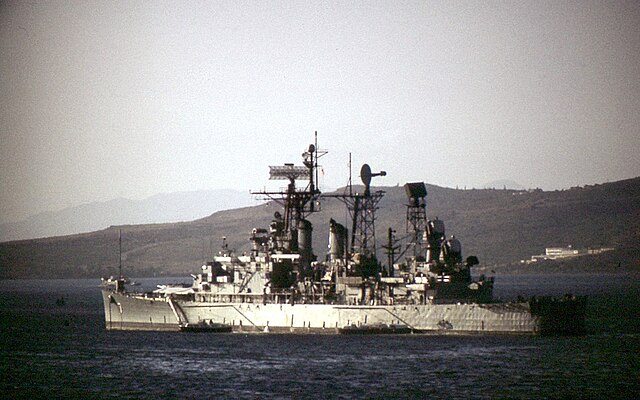
Suda Bay, Crete, 1972
Sprinfield was commissioned on 9 September 1944 at Boston and saw action in WW2. She took part on the Okinawa campaign with TF 58, earning 2 battle stars. Back to the West Coast on 1 June 1949 she had an inactivation overhaul, joined the San Francisco Group, Pacific Reserve Fleet until March 1957. She was converted at Fore River Yard as CLG- (more than three years), recom. on 2 July 1960, followed by acceptance trials (New England coast), shakedown in Cuba. She made a first TOD in the Mediterranean Sea, relieving USS Des Moines as flagship 6th Fleet. In May-December 1963, she had an OVL in Brooklyn and returned with the 6th Fleet until 1967. She was replaced as flag by Little Rock and entered Boston NyD on 16 February 1967 for a six-month overhaul. Later she relieved Newport News as flag, 2nd Fleet. Her tour included Britain, Amsterdam, Lisbon, Barcelona, and Majorca, then back to Norfolk. She took part in a midshipman cruise and by 12 September 1968, she took part in NATO exercise “Silver Tower” in northern sea and arctic. When back she started a restricted availability.
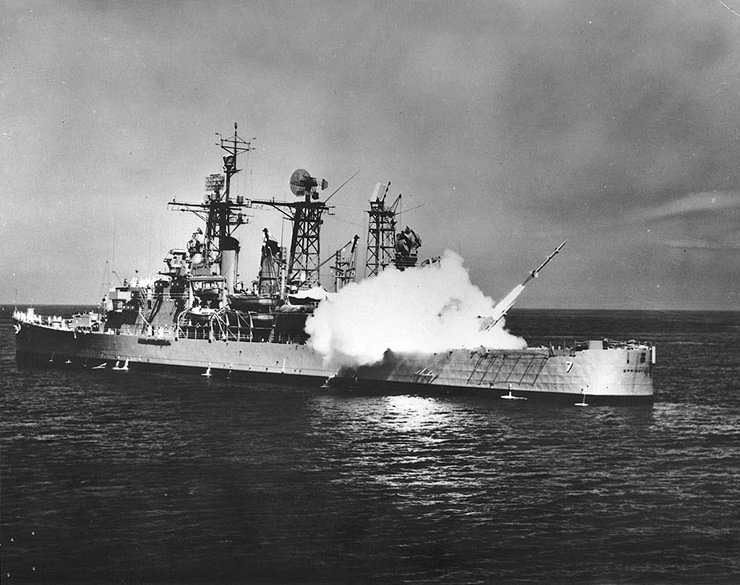
Firing her Terrier on 6 June 1961
On 14 January 1970, USS Springfield relieved USS Newport News again as flag, 2nd Fleet and back 7 months later, and later releived USS Little Rock as flag, 6th Fleet. She hosted notably President Richard Nixon and the Secretary of the Navy. On 28 September 1970 this was a major conference with all commanders of U.S. Naval Forces, Europe, 6th Fleet. In April 1973 she became the command ship for flood relief operations in Tunisia, later relieved by Little Rock on 1 September 1973. In Boston she was scheduled for an expensive refit and she was decommissioned instead. On 17 September she sailed for Norfolk an inactivation, then Portsmouth, stricken 15 May 1974 and later sold for Bu.
 USS Topeka CLG-8 (rec. 1960)
USS Topeka CLG-8 (rec. 1960)
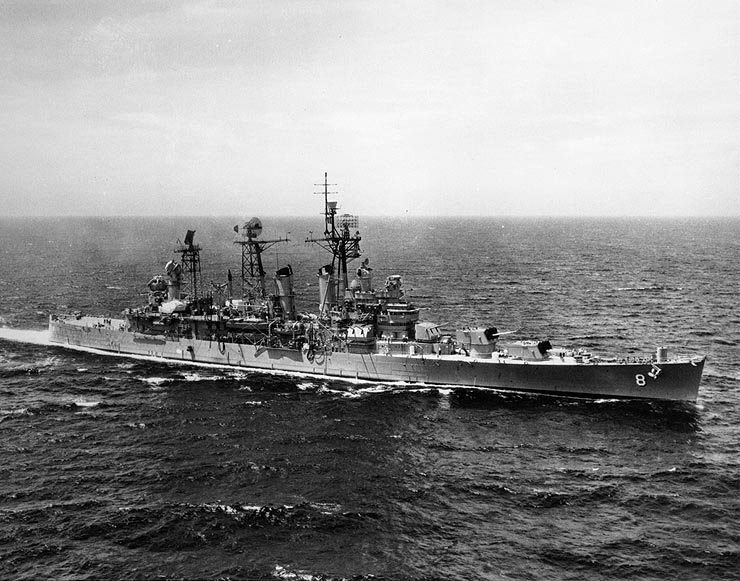
USS Topeka was commissioned on 23 December 1944 and saw the end of the Pacific war, followed by Med TODs until February 1949. On 25 February she was prepared at San Francisco for inactivation, decommissioned there on 18 June, Pacific Reserve Fleet. In 1957 she was towed to NyC NyD on 15 April, starting conversion as CLG-8, over 3 years. She was yet the only one not upgreaded as command ship (SBC 146). Recommissioned on 26 March 1960, she started service on the west coast, HP Long Beach. For three years, she alternated two WestPac and local operations. She visited Hong Kong, the Philippines, Okinawa, and rounded Japan, plus exercizes with the 7th Fleet and ASEAN navies.
By March 1964, the Maddox incident in the Gulf of Tonkin had her deploys in patrols until October and back to Long Beach. Next she served with the 1st Fleet when not in overhaul.She departed for her next wartime WestPack on 29 November 1965 as flagship, Commander, Cruiser-Destroyer Group (7th Fleet) between teh South China Sea and Gulf of Tonkin between gunfire support and air operations, until 28 May 1966. On 31 October she entered San Francisco NyD for an overhaul until March 1967. By 1 August she made her first deployment to the Mediterranean via Norfolk, Virginia, and emnarked the Commander and staff of CruDesFlot 12 to Palma de Majorca and to the 6th Fleet at Rota, flagship for TG 60.2. She took part in NATO exercise Eager Beaver, close to the middle east seaboard, Ionian and Tyrrhenian Seas, completing this in January 1968, relieved by USS Columbus at Rota.
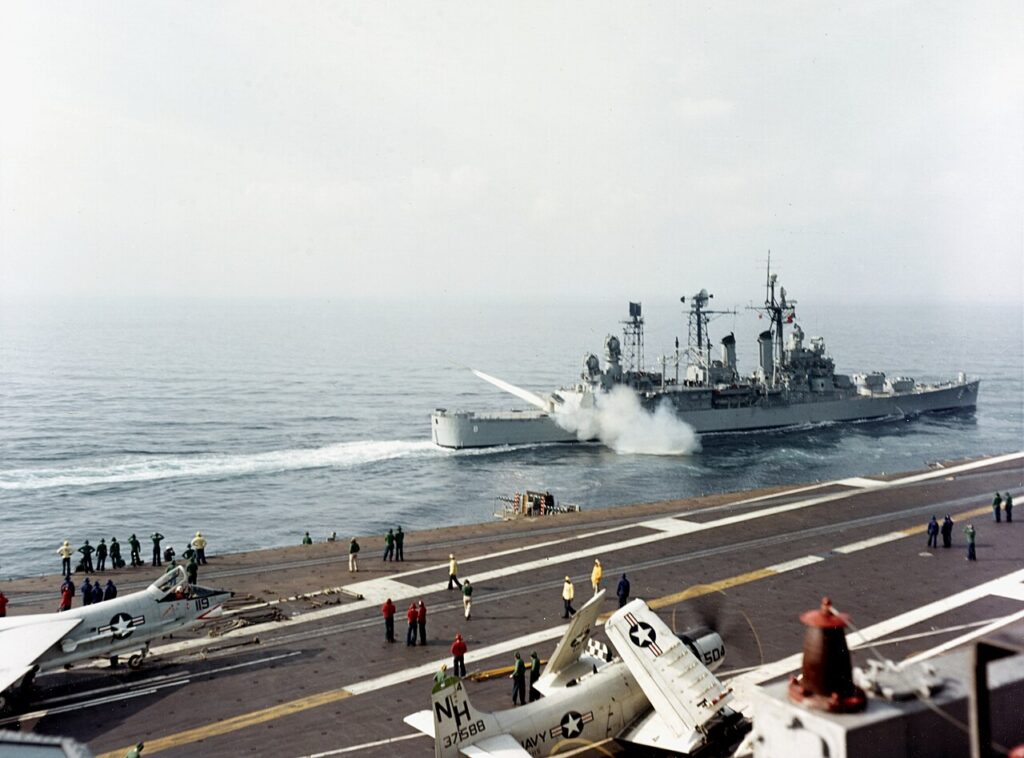
USS Topeka (CLG-8) fires a “Terrier” missile on 18 November 1961 during weapons demonstrations for the Chief of Naval Operations, Admiral George W. Anderson. The photo was taken from the aircraft carrier USS Kitty Hawk (CVA-63). A Douglas AD-6 Skyraider (BuNo 137588) of Attack Squadron 115 (VA-115) “Arabs” prepares for launch. A Vought F8U-1 Crusader of Fighter Squadron 142 (VF-142) “Fighting Falcons” is partly visible on the left.
Homeported to Mayport, Florida she stayed under upkeep, made a refresher training off Cuba, and was prepared for her last Med TOD from 29 June, relieving on 9 July USS Columbus at Málaga, and this last rour was routine with ports visits and sercizes. She was back at Rota, replaced as flag by Columbus and back to Mayport. On 30 January 1969 she sailed to Boston on 5 February for inactivation, with decommission on 5 June, berthed at Philadelphia, stricken 1 December 1973, sold 20 March 1975. Overall she earned 2 battle stars for World War 2 and 3 battle stars for Vietnam.

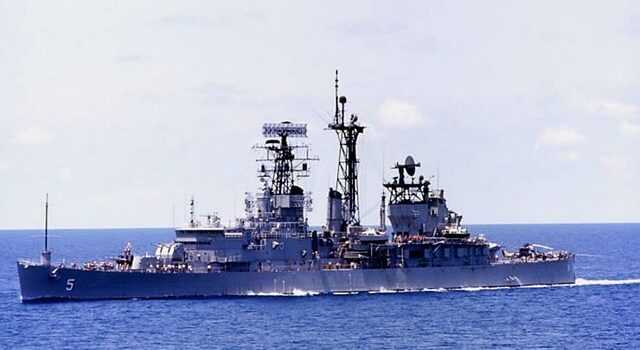
 Latest Facebook Entry -
Latest Facebook Entry -  X(Tweeter) Naval Encyclopedia's deck archive
X(Tweeter) Naval Encyclopedia's deck archive Instagram (@navalencyc)
Instagram (@navalencyc)





 French Navy
French Navy Royal Navy
Royal Navy Russian Navy
Russian Navy Armada Espanola
Armada Espanola Austrian Navy
Austrian Navy K.u.K. Kriegsmarine
K.u.K. Kriegsmarine Dansk Marine
Dansk Marine Nautiko Hellenon
Nautiko Hellenon Koninklije Marine 1870
Koninklije Marine 1870 Marinha do Brasil
Marinha do Brasil Osmanlı Donanması
Osmanlı Donanması Marina Do Peru
Marina Do Peru Marinha do Portugal
Marinha do Portugal Regia Marina 1870
Regia Marina 1870 Nihhon Kaigun 1870
Nihhon Kaigun 1870 Preußische Marine 1870
Preußische Marine 1870 Russkiy Flot 1870
Russkiy Flot 1870 Svenska marinen
Svenska marinen Søværnet
Søværnet Union Navy
Union Navy Confederate Navy
Confederate Navy Armada de Argentina
Armada de Argentina Imperial Chinese Navy
Imperial Chinese Navy Marinha do Portugal
Marinha do Portugal Mexico
Mexico Kaiserliche Marine
Kaiserliche Marine 1898 US Navy
1898 US Navy Sovietskiy Flot
Sovietskiy Flot Royal Canadian Navy
Royal Canadian Navy Royal Australian Navy
Royal Australian Navy RNZN Fleet
RNZN Fleet Chinese Navy 1937
Chinese Navy 1937 Kriegsmarine
Kriegsmarine Chilean Navy
Chilean Navy Danish Navy
Danish Navy Finnish Navy
Finnish Navy Hellenic Navy
Hellenic Navy Polish Navy
Polish Navy Romanian Navy
Romanian Navy Turkish Navy
Turkish Navy Royal Yugoslav Navy
Royal Yugoslav Navy Royal Thai Navy
Royal Thai Navy Minor Navies
Minor Navies Albania
Albania Austria
Austria Belgium
Belgium Columbia
Columbia Costa Rica
Costa Rica Cuba
Cuba Czechoslovakia
Czechoslovakia Dominican Republic
Dominican Republic Haiti
Haiti Hungary
Hungary Honduras
Honduras Estonia
Estonia Iceland
Iceland Eire
Eire Equador
Equador Iran
Iran Iraq
Iraq Latvia
Latvia Liberia
Liberia Lithuania
Lithuania Mandchukuo
Mandchukuo Morocco
Morocco Nicaragua
Nicaragua Persia
Persia San Salvador
San Salvador Sarawak
Sarawak Uruguay
Uruguay Venezuela
Venezuela Zanzibar
Zanzibar Warsaw Pact Navies
Warsaw Pact Navies Bulgaria
Bulgaria Hungary
Hungary

 Bundesmarine
Bundesmarine Dutch Navy
Dutch Navy Hellenic Navy
Hellenic Navy Marina Militare
Marina Militare Yugoslav Navy
Yugoslav Navy Chinese Navy
Chinese Navy Indian Navy
Indian Navy Indonesian Navy
Indonesian Navy JMSDF
JMSDF North Korean Navy
North Korean Navy Pakistani Navy
Pakistani Navy Philippines Navy
Philippines Navy ROKN
ROKN Rep. of Singapore Navy
Rep. of Singapore Navy Taiwanese Navy
Taiwanese Navy IDF Navy
IDF Navy Saudi Navy
Saudi Navy Royal New Zealand Navy
Royal New Zealand Navy Egyptian Navy
Egyptian Navy South African Navy
South African Navy






























 Ukrainian Navy
Ukrainian Navy dbodesign
dbodesign